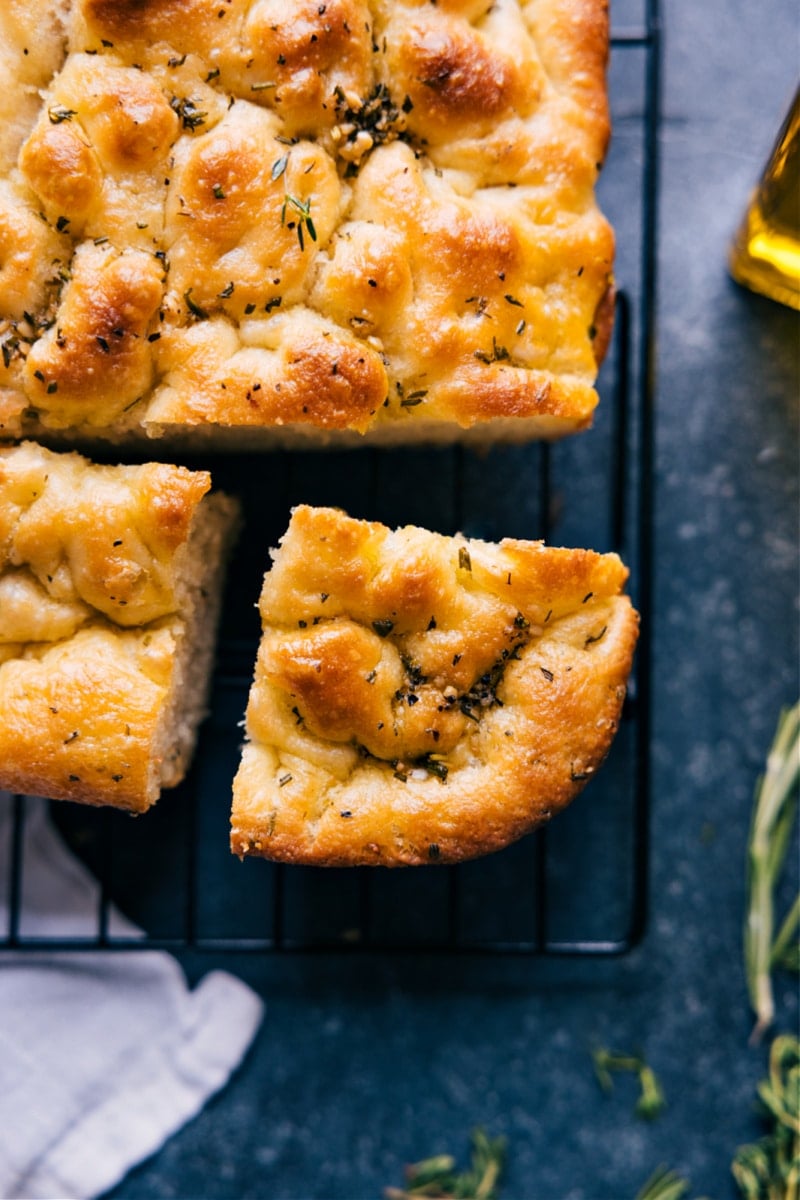[ad_1]
This is our favorite Focaccia — it has a crisp, salty crust, a light and chewy texture, and rich flavor. This fragrant Italian bread can be made in a 9×13-inch pan for the perfect sandwich bread or in a half-sheet pan for the ultimate snacking bread. Plus we’re sharing how to make plain bread as well as an herbed version!
Check out some of our other easy bread recipes like this No Yeast Bread or simple White Bread.

The photo above this text along with the last one in this recipe post are of the “Herbed Focaccia.” The rest of the step-by-step tutorial photos in this post are of the plain/standard version without herbs. Both recipes are included in the recipe card below.
Focaccia Recipe
This flat Italian delight is hands-down my favorite bread. From the richness of the added olive oil to the fragrance of the garlic and herbs to the salted crisp top to the soft chewy interior — every bite is an experience!
And this is the best focaccia bread recipe because it also happens to be easy to make! No stand mixer or bread maker needed or no kneading, for that matter. Additionally, you’ll need no special tools or utensils and no crazy ingredients or complicated methods.
In fact, most of this recipe is pretty hands-off. This fluffy Focaccia recipe is based on Sarah Jampel’s recipe shared on Bon Appetit’s website. It’s taken the internet by storm because of its simplicity and amazing flavor. So today I’m sharing my adaptations along with my tips and tricks after making this bread an embarrassing amount of times. Thanks, Sarah!

Focaccia Ingredients
- Olive oil. The better the oil used, the richer the flavor will be. We recommend extra virgin olive oil.
- Warm water. We want to provide an ideal environment for yeast — see “quick tip” below.
- Yeast. It provides the leavening for the dough causing it to rise and expand.
- Flour. We use plain, all-purpose white flour here.
- Honey. This sweetener is food for the yeast and will help it grow nicely.
- Salt. Salt is an under-appreciated ingredient. It adds flavor and without it, the bread will taste bland and flat. Salt is also important to the bread’s structure. It tightens the gluten structure and helps control the pace of yeast fermentation.
- Butter. Besides adding the perfect finishing flavor to the bread, butter helps grease the pan so nothing sticks.
QUICK TIP
How to tell when your water is at the right temperature? Use the wrist test! Drizzle a few drops of the warmed water onto the inside of your wrist. If it is warm and comfy for you, it will be perfect for the yeast. If it is not warm and instead feels hot, it will be too hot for the yeast. Too cold and the yeast will simply remain dormant.

Let’s Chat Yeast
Proofing the yeast shows tells us if the yeast is still alive and active (yeast is a living organism). We have tested and included directions for both active dry yeast and instant yeast in this recipe — either will work and both have been tested.
I find it very helpful to make sure you can see the yeast has been activated before moving on to the next steps. If the yeast doesn’t activate, the Focaccia won’t rise nicely. Better to find that out right away instead of going through all the steps and ending up disappointed.
- When activated, yeast will grow, get foamy and appear creamy.
- Why didn’t my yeast activate? If the yeast doesn’t prove, this can be because the yeast is old (dead), the water was too hot, or the water/environment is too cold. If the water/environment is too cold, the yeast might wake up but release a substance that hinders the formation of gluten in the bread.

How to Make Focaccia
The full Focaccia recipe is below, so here we’ll give some tips for success:
- Don’t skip the refrigeration. When we add the dough to the fridge we’re slowing down the fermentation process. This overnight Focaccia has a noticeably complex flavor since the yeast is able to chill and develop.
- Generously grease the pan. It may seem like overkill to use cooking spray, softened butter, and olive oil to grease the pan, but we can’t overstate the importance of a generously greased pan for easy removal of the bread. Plus, it gives the base of the bread a really great flavor and crispiness.
- No kneading! Really, when we say no kneading we mean it! This dough is intentionally a very wet dough, so kneading would be difficult anyway. Don’t over-work or over-handle the dough; it needs very minimal amounts of handling.
- Add butter right before eating. We brush melted butter over the bread, but it will soften those crispy tops if not enjoyed soon after. Only brush butter on what will get eaten immediately after topping.
Focaccia Toppings
This bread is known for being seasoned with herbs and olive oil, so we’ve included two versions: a basic, standalone bread and one infused with a fragrant herb blend. Here’s our favorite herbed blend:
- Olive oil
- Fresh thyme
- Fresh rosemary
- Cracked black pepper
- Minced garlic
Firmly pinch the stem of thyme or rosemary near the top. Using your other hand, run the fingers down the length of the stem from top to bottom to pull off the herbs before finely chopping.
QUICK TIP
If you prefer, dried herbs can be used instead!

Focaccia FAQs
Focaccia is a flat oven-baked Italian bread reminiscent to pizza dough in style and texture.
Typically this bread is seasoned with olive oil, salt, and herbs.
2How to pronounce Focaccia
Focaccia is pronounced fo-kah-cha.
3How is Focaccia different from bread?
This Italian Focaccia recipe is a very wet dough. It’s similar to pizza dough, but with a much higher amount of yeast (so it will rise more/be more fluffy and bread-like).
This type of bread is punctured all over with fingers before baking which maintains even more moisture.
4What is special about Focaccia?
- Focaccia is rich in olive oil giving it a wonderful flavor and making it more satiating
- The texture is superb with crispy golden crunchy top and bottom with a chewy interior.
- Focaccia’s airy crumb means there are lots of air holes giving it a sponge-like texture.
5Is Focaccia a healthy bread?
Focaccia bread certainly has its space as part of a healthful diet. It is a great source of vitamins and minerals as well as healthy fats found in olive oil.
Is Focaccia better than bread?
Focaccia tends to have greater satiating power (it will fill you up more or for longer) than white bread since it has the healthy fats from olive oil. Additionally, it doesn’t contain simple sugars (like white sugar) that are frequently found in white bread, but does not offer satiation.
6What is the difference between Focaccia and pizza dough?
The primary difference is the amount of yeast added to the dough. Focaccia has much more yeast giving it a lighter and fluffier texture.
7What is the difference between Focaccia and ciabatta?
This Focaccia bread recipe has a lighter consistency while ciabatta is more dense and chewy.
Focaccia is baked as a flatbread while ciabatta is baked as loaves.

STORAGE
Storage
Focaccia is best eaten the day it’s made — it’s so good right out of the oven! This bread doesn’t store especially well at room temperature beyond a day but keeps well in the freezer. Slice it into pieces, tightly wrap pieces in plastic wrap and then store the wrapped pieces in a large freezer-safe bag or container. Freeze for up to 3 months. Reheat, unwrapped on a baking sheet, in a 300 degrees F (150 degree C) oven.

What is Focaccia traditionally eaten with?
- This bread is a wonderful addition to a bread basket — completely delicious on its own! (Perfect for picnic food or a charcuterie board!)
- A great accompaniment to a bowl of soup or a salad (We suggest this Olive Garden Salad and Minestrone Soup — so good!)
- Replace your toast with this bread — it makes a wonderful breakfast or brunch!
- Use for sandwiches. We love sandwiches on this bread — these Pesto Chickpea Sandwiches or Club Sandwich are our two favorites.
- Use leftover (stale) Focaccia for homemade croutons, breadcrumbs, or stuffing.
More Italian-Style Recipes:
Focaccia
This is our favorite Focaccia — it has a crisp, salty crust with a light and chewy texture and rich flavor. This fragrant Italian bread can be made in a 9×13-inch pan for the perfect sandwich bread or in a half-sheet pan for the for ultimate snacking bread. Plus we’re sharing how to make a plain bread as well as an herbed version!

Focaccia

This is our favorite Focaccia — it has a crisp, salty crust with a light and chewy texture and rich flavor. This fragrant Italian bread can be made in a 9×13-inch pan for the perfect sandwich bread or in a half-sheet pan for the for ultimate snacking bread. Plus we’re sharing how to make a plain bread as well as an herbed version!
Ingredients
- 6 tablespoons olive oil, separated (plus 1 teaspoon for oiling your hands)
- 2-1/2 cups (535g) warm water
- 2-1/4 teaspoons (7g) instant yeast OR active dry yeast (either works!)
- 1 tablespoon (20g) honey
- 5 cups (675g) all-purpose, white flour
- 1 tablespoon (18g) fine sea salt
- 3 tablespoons unsalted butter, separated
- Flaky sea salt, for topping bread (optional)
OPTIONAL: Herbed Foccacia
- 2 teaspoons minced garlic
- 1 tablespoon chopped fresh thyme (or 1 teaspoon dried)
- 1 tablespoon chopped fresh rosemary (or 1 teaspoon dried)
- 1/4 teaspoon pepper
Instructions
-
QUICK TIP: It may be helpful to watch the tutorial video in this recipe post before starting! YEAST: Whisk 2-1/4 tsp. yeast, 1 tbsp. honey, and 2-1/2 cups warm water in a medium bowl and let sit 5 minutes (It should look creamy/foamy after 5 minutes (see photo). (If not, your yeast is dead and you’ll need to begin again. Either the yeast is dead or the water was too hot.)
-
(OPTIONAL) HERBED OIL: Skip this step and use regular olive oil for a plain focaccia bread. Otherwise, prepare this herbed oil for an herbed bread. In a small pot, add 6 tbsps. olive oil, 2 tsp. minced garlic, 1 tbsp. thyme, 1 tbsp. rosemary, and 1/4 tsp. black pepper. Place the pan over lowest heat setting and cook, stirring occasionally, for 5 to 10 minutes or until fragrant, but don’t brown/burn the garlic! Set aside to cool.
-
DOUGH: In a very large bowl (that will fit in your fridge) add 5 cups all-purpose flour (Note 2) and 1 tbsp. fine sea salt and mix with a rubber spatula until a shaggy dough forms and no dry streaks of flour remain. Using the spatula, gently press the dough to one side of the bowl and pour in 4 tablespoons of the herbed (or plain) olive oil. Using both your hands, pick up all the dough (it’s very sticky and wet!) and turn it around twice to fully coat in oil.
-
OVERNIGHT RISING TIME: Cover oiled dough with plastic wrap and chill in the fridge until dough is doubled in size (it should look bubbly and be wobbly), at least 8 hours and up to 24 hours. We highly recommend chilling overnight (better flavor!) but if you want to bake right away instead of chilling in the fridge, see Note 3. Pull out 3 tablespoons butter to set at room temperature overnight so it is very soft in the morning.
-
PREP PAN: See Note 1 to decide what pan you want to use. We want a really well-greased pan so we can easily remove the bread — using your hands rub 1 tablespoon softened butter to generously grease the pan and then also lightly spray with cooking spray. Drizzle in 1 tablespoon of herbed or plain oil. Using your hands smooth oil evenly across bottom of pan.
-
2ND RISING TIME: Remove dough from the fridge and holding a fork in each hand, gather up the dough farthest from you and lift it up and over the center of the bowl. Give the bowl a quarter turn and repeat the process. Repeat 2 more times for a total of 4 times. Gently dump the dough into the prepared pan. Use a spatula to scrape any leftover oil right on top of the dough. Don’t spread dough out at all, just let it be. Let dough rise, uncovered in a dry/warm spot (like on top of a preheating oven). Let rise until doubled in size about 1-1/2 up to 3 hours. (Move somewhere warmer if it isn’t rising.) You’ll know the dough is ready when if poked, it springs back slowly leaving an indentation (if it springs back quickly, it isn’t quite ready).
-
BAKE: Place a rack in middle of oven; preheat to 450 degrees F (230 degrees C). Lightly oil your hands with about 1 teaspoon oil. Gently press/stretch dough to fill pan. If it resists, let it stand another 10 minutes. Dimple focaccia all over with your fingers, creating deep depressions in the dough (hit your fingers all the way to the bottom of the pan). If making plain focaccia, drizzle with remaining 1 tbsp plain oil (do not add extra herbed oil on top here because garlic will burn on top). Bake focaccia until puffed and golden brown all over, about 20–30 minutes in the 13×18-inch pan or 25-35 minutes in the 9×13-inch pan. Remove from oven and let stand for 10-15 minutes (steam is still cooking the bread so resist the urge to cut in). For herbed focaccia, right out of the oven, use a pastry brush to brush on the last 1 tablespoon of herbed oil.
-
TOPPING: Hold off on this last step until you’re ready to serve the focaccia: (This is for the plain focaccia only) Melt the remaining 2 tablespoons butter in the microwave. Use a pastry brush to brush this melted butter only over what you’ll be eating. If desired lightly sprinkle with sea salt. Cut into squares and enjoy warm! If you want this bread for sandwiches, cut into squares then use a sharp serrated knife to cut the squares in half widthwise.
-
STORAGE: Focaccia is best eaten the day it’s made — so good right out of the oven! It doesn’t store especially well at room temperature beyond a day, but keeps well in the freezer. Slice it into pieces, tightly wrap pieces in plastic wrap then store wrapped pieces in a large freezer-safe bag or container. Freeze for up to 3 months. Reheat, unwrapped on a baking sheet in a 300 degrees F (150 degree C) oven.
Recipe Notes
Note 2: Flour: Measuring flour can greatly vary person to person. If you have a food scale, I highly recommend pulling it out for this measurement. Too little flour and the dough will be too wet and dough too sticky; too much and the bread will be overly dense. No food scale? Make sure to completely fill up the cup measurer then level the top off with the back of a butter knife.
Note 3: Baking WITHOUT Chilling Overnight: Let bread rise at room temperature (70 degrees F) until doubled in size, about 3-4 hours and then bake.
Nutrition Facts
Serving: 1serving | Calories: 343kcal | Carbohydrates: 55.3g | Protein: 7.5g | Fat: 10.1g | Sodium: 1.9mg | Fiber: 2.1g | Sugar: 2.1g
We do our best to provide accurate nutritional analysis for our recipes. Our nutritional data is calculated using a third-party algorithm and may vary, based on individual cooking styles, measurements, and ingredient sizes. Please use this information for comparison purposes and consult a health professional for nutrition guidance as needed.
[ad_2]
Source link





